COBASOFT CLOCK

TUCOWS

A single-user license costs only $ 9.95! You can buy online from DIGIBUY and REGNOW or per FAX from Cobasoft .
 The Cobasoft Clock makes some of your daily tasks easier and faster:
The analog clock looks good in
the system taskbar and it is one control center of the clock.
The report tracks the usage of your computer
and the current project.
The alarms and timers
can be set very quickly.
The timestamp can copy the current date
and/or time into the clipboard.
And the clock can display the current moon phase
as another icon.
Installation is easy, just start the 'setup' shortcut.
See also: AutoStart,
Invisible and
Uninstall.
The Cobasoft Clock makes some of your daily tasks easier and faster:
The analog clock looks good in
the system taskbar and it is one control center of the clock.
The report tracks the usage of your computer
and the current project.
The alarms and timers
can be set very quickly.
The timestamp can copy the current date
and/or time into the clipboard.
And the clock can display the current moon phase
as another icon.
Installation is easy, just start the 'setup' shortcut.
See also: AutoStart,
Invisible and
Uninstall.
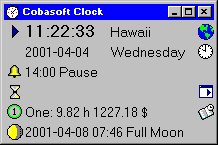
With these control panels you view and control: the current date and time, the world time zone, the next alarm and next timer, the current project and its sums and the next moon phase. You can open the report, and open new windows. You can use the buttons or the keyboard.

The analog clock shows the current time. You can open the context menu by pressing the right mouse button, Shift-F10 or the context menu key on. You can set a world time zone for every clock.
Right-Click: Main Clock Menu
Right-Click+Shift: QuickMode Alarm
Right-Click+Ctrl: QuickMode Timer
|
Copy Timestamp... Edit Alarms... Edit Timers... Choose Project... Show Report... Set World Time... Change Date Time... Create New Window... Toggle Caption!... Toggle Seconds!... Options... Help... Close! Exit! |
|
Exit! Uninstall Options... Create New Window... Help... Show Report... Choose Project... Edit Alarms... Edit Timers... Copy Timestamp... |

The alarms window consists of a hint window, an area with 9 marker colors and the alarm scale. The hint window is in the top-left edge. It will show the name and color of a marker when you pass with the mouse over the marker. It will show the time when you drag a marker on the scale. The alarm window works in QuickMode when you start it by holding the shift key and clicking with the right mouse button on the clock icon in the taskbar. It will then close automatically when you have set or modified a single alarm. This means that you can set an alarm (or timer) with only 2 mouse click. Every tick on the alarm scale represents 5 Minutes. You can choose one of 9 marker colors by clicking in the marker color area. You can set a large number of alarms (in fact, one for each tick of the scale) and the properties of the alarms are defined by one of the 9 marker types. Each marker type defines the color, text and other properties of one alarm or timer. See Marker Settings for further details. You set an alarm by clicking on the alarm scale or by clicking into the color area and dragging into the scale area. You modify an alarm by dragging it around. You delete an alarm by dragging it outside the scale area. The mouse cursor will change to indicate the action. You can press Ctrl-Del to delete all alarms. Pressing F10 or right-clicking anywhere in the window opens a context menu. There you can close the window, clear all alarms or modify the Marker Settings. In the context menu you can also set the zoom to 100, 150 or 200 percent. This will enlarge the whole window content and make it easier to use. A right-click on the color area of a marker directly opens the settings dialog for that marker! The alarms window is closed by pressing the Enter or Escape key or by clicking on the close box.

The timers window window works more or less like the alarms window. The timers window goes into QuickMode when you start it directly by holding the control key and clicking with the right mouse button on the clock icon in the taskbar. If you have set some timers and keep this window open long enough, you can see the timer pins walk left once every minute until they trigger a notification. You can have one timer for every minute and the timers have their own 9 marker types, as described in: Marker Settings. If the marker has a dynamic note, then the note is also shown in the notification text.
The alarm or timer notifications look like this:
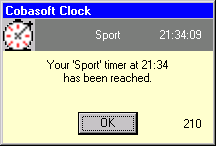
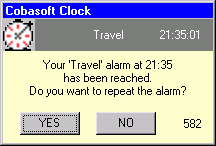
The number in the bottom-right edge is a countdown timer. It closes the notification window automatically and stops the sound. It is only used when a timeout has been specified in the Marker Settings.
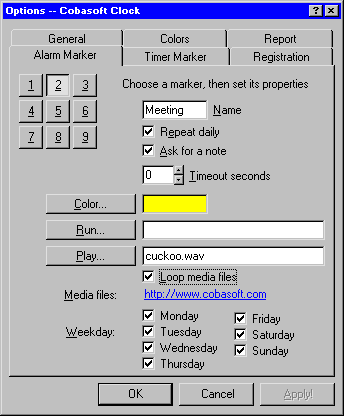
This dialog is used to edit the alarm or timer marker settings. There a 9 markers for alarms and 9 for timers. (You can set 140 timers and 288 alarms but there are only 9 different marker types for each class available). Both marker types have nearly the same properties, but the 'Repeat daily' feature is only available for alarms. The pressed marker button indicates the currently active marker, you can choose any of the 9 markers. The marker name field contains up to 8 characters, these are shown in the hint area of the alarm or timer settings window and in the alarm or timer notification. The Color... button is used to choose a predefined or self-composed color for the current marker. This color is used to paint the alarm or timer indicator pins and the marker rectangles in the alarm or timer window. By pressing the Run... button you can choose a file that should be started when an alarm or timer is triggered. By pressing the Play... button you can choose a file that should be played when an alarm or timer is triggered. You can also modify both file names directly. WAV, MID or RMI files can be played and you can choose to loop these files until the alarm or timer notification message is closed. (Some sample WAVs are include with the Clock and you can go to our media web page to look for more and newer files!) Other types of files can be run, too. For example DOC, TXT, HTM and BMP files usually can be specified in the 'run' field and Windows will then open the right program for them. You can also 'run' media files for which the internal 'play' does not work. A notification timeout greater than 0 (zero) shows a countdown timer in the notification window and closes it automatically. Sounds are stopped, too. Other started programs or documents continue to run.

The projects window allows you to switch to another project and view the current settings of a project. The sums of the current project are updated live while this window is open! The window also has a shortcut to the project settings window.

The report keeps track of activities on your computer. You can use it to keep track of the projects you worked on or of what others did with your machine while you were away. The tracking is done automatically by recording the actice window's title and the time and duration during which the window was active. Pauses in user activity are usually indicated by long times during which no other window was activated. A new header is written into the report when a new day starts, when the Cobasoft Clock is started and when another project is choosen. The header contains the name of the user and the name of the current project. The current project number is shown in the report lines. The Cobasoft Clock writes the report to a file. You can use the Report Settings dialog to activate the report or choose a name for the report file. When you turn on the Invisible feature, the report can be written without the clock icons being visible. You open the Report file by Choosing 'Show Report' on the main menu. A text editor (usually Notepad) is then started to show the report file. The report is comma-separated so that it can be imported into other programs.
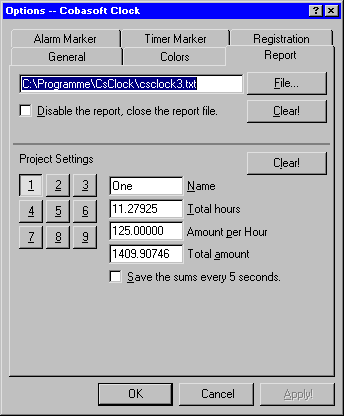
This window has two parts: report settings and project settings. For the report you can choose the name of the report file and enable or disable the report. A new header is written to the report file if the name of the report file is changed, when the clock starts and when a new project is choosen. The project settings contain the name, total hours, amount per hour and total amount for each project. You can use a cost centre number, the name of your client or any free text as the name of the project. The total hours and total amount are always computed autmatically, you can reset them (per project) by pressing the Clear! button. All amounts are stored in the registry, usually when the Clock ends. To be sure that you don't loose times, you can check the 'Save the sum every 5 seconds' checkbox.
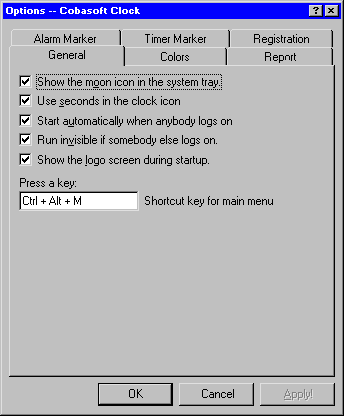
Show Moon By checking or unchecking the Show Moon menu item, you can show or hide the moon phase display. The moon phase icon
 is shown near the usual clock icon
and it displays the moon phase of the current day and time.
When you move the mouse over the icon and hold it there
without pressing a button, the tooltip
will appear and show more detailed information about the
moon phase.
is shown near the usual clock icon
and it displays the moon phase of the current day and time.
When you move the mouse over the icon and hold it there
without pressing a button, the tooltip
will appear and show more detailed information about the
moon phase.Use Seconds:Turn on or off the seconds of the clock icon.
Autostart: By checking or unchecking the "Start automatically when anybody logs on" menu item, you can enable or disable the autostart feature. If AutoStart is set, then the Cobasoft Clock will be loaded any time somebody logs on to the computer. Cobasoft Clock uses a registry setting for AutoStart, it does not need entries in any 'Startup' folder of the Windows 'Start' menu.
Invisible: By checking or unchecking the "Start automatically when anybody logs on" menu item, you can enable or disable the Invisible feature. When it is enabled then the Cobasoft Clock icon will only be displayed for you! Nobody else who uses the same computer will see the the clock although the report will continue to work! This only works if the Cobasoft Clock can find the name of the currently logged-on user. Under Windows NT and Windows 2000 this is always the case but under Windows 9x and Windows Me the user name may not be available because the computer starts without requiring any log-in.
Logo: The logo can be turned off if the Cobasoft Clock has been registered.
Hotkey: Here you can define a keyboard shortcut for the Cobasoft Clock tray icon menu. This shortcut can be used from any application! Make sure that the cursor is in the input field, then press and hold the wanted keyboard keys together. The input field will show a string that represents the keys, like "Ctrl + Alt + M". Then press OK to activate the shortcut. The shortcut cannot be used to start Cobasoft Clock because it is only available while Cobasoft Clock is running. Valid key combination have to include the ALT key. You can delete the shortcut key by pressing DEL in the input field.
The hot key allows you to set some options faster by using the keyboard instead of the mouse. For example:
<Ctrl-Alt-M>CC copies the timestamp into the clipboard,
<Ctrl-Alt-M>CD copies the date into the clipboard,
<Ctrl-Alt-M>R opens the report,
<Ctrl-Alt-M>A opens the alarms window.
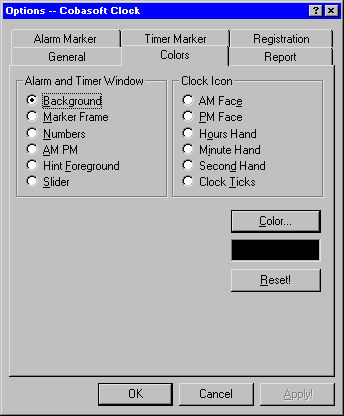
This dialog is used to edit the color settings of the clock icon, alarm and timer windows. You can press the Color button to select or compose colors for any of the drawing elements and you can press Reset to reset every single color to its default.
The Cancel button will just close the window without applying the changes. (The hint background color is not used anymore because the alarm and timer windows now show the hint in the color of the marker.)
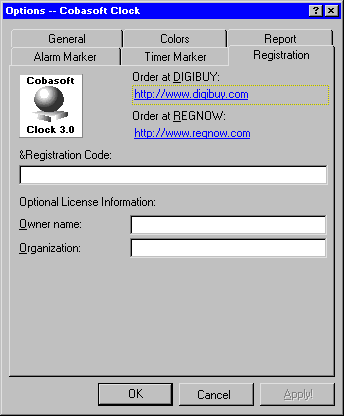
By filling out the license information you indicate that you are the owner of this software. You can immediately go online to order Cobasoft Clock. Pressing one of the Web link buttons will open a browser and go to the web site where you can shop immediately for single or multiple licenses of Cobasoft Clock.
An unlicensed copy of Cobasoft Clock has a trial period of 30 days and the startup logo cannot be turned off.
Using the license key: When you buy Cobasoft Clock you get RegCodes which look like this: "
1109001-025000-200005-000000 2LKMNO98*&0+".
This code consists of two parts:
the serial number and the
registration
key
, separated by a space. You cut-and-paste (or type)
the RegCodes into the "Registration Code" field of the dialog
and press "OK". When the code is valid, the Cobasoft Clock is unlocked
and you can use it without restrictions.
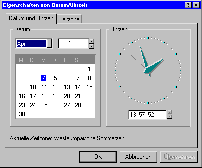
The Cobasoft Clock can start the standard Windows date and time dialog. Setting a date and time there will affect all programs on you computer and it will change the date and time for the tray icon of the Cobasoft Clock.
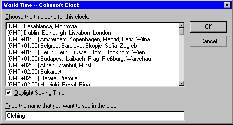
With this dialog you can choose a world time zone for every clock window! You can also edit the string (at the bottom of the dialog) so that it shows any name you like, for example the name of your home town.
"\SOFTWARE\Cobasoft\Clock".
"\SOFTWARE\Cobasoft\Clock".
If there is an entry with the name 'Log' then its string value
will be used as filename for the report file. If the value is
missing then the default
"%TEMP%\csclock.txt"
is used.
(%TEMP% is a placeholder for the temporary-files
directory.)
email:
🖃 cs
@
cobasoft.net
Copyright (c) since 1999, Karl-W.Geitz, Cobasoft GmbH